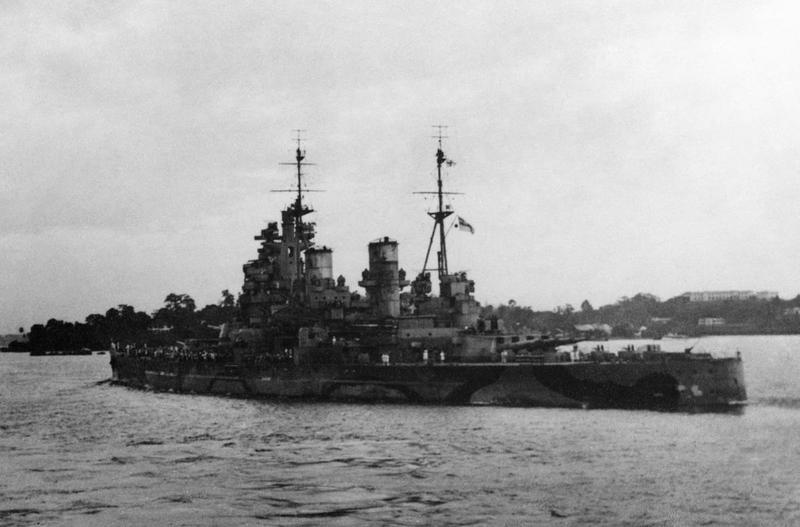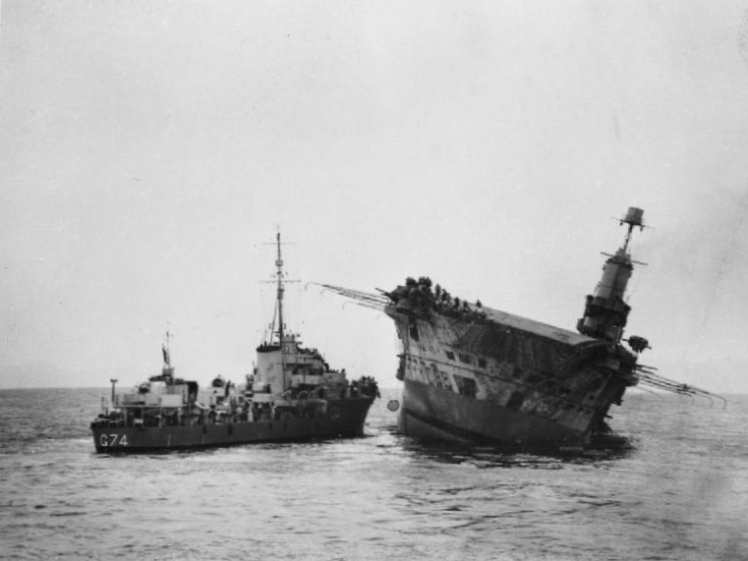The loss of Prince of Wales and Repulse off the Malayan coast on 10 December 1941 – described in the previous two articles – set alarm bells going in Britain. It marked the first time heavy ships had been lost to air attack, while fully operational and manoeuvering at sea. In this last article in the series we look at the investigations – and why it took around 70 years to answer some of the questions.
HMS King George V. Drawing by Bombhead, via Shipbucket, Creative Commons Attribution-NonCommercial 4.0 International License.
The loss of Repulse was, perhaps, understandable. She had been built to First World War standards of underwater protection.[1] However, Prince of Wales was a modern battleship whose underwater defences were designed to defeat larger charges than those carried by Japanese aerial torpedoes – up to 375 kg of TNT, versus the 150 to 200 kg charges carried by the various models of torpedo that sank the ship. The underwater protection system had been developed from full-scale tests during the 1930s against a test structure dubbed ‘Job 74’, and was standard on all the King George V’s.[2] The disturbing part was that the same system was shared with the new aircraft carriers;[3] and in mid-November 1941 the carrier Ark Royal had succumbed to a single U-boat torpedo off Gibraltar.[4] At the time, nobody knew exactly why she went down, but now Prince of Wales was also lost. Had some disastrous miscalculation been made in the design? If not, what had happened?
HMS Legion approaches the carrier HMS Ark Royal after she had been torpedoed by U-81 in mid-November 1941. The carrier had the same underwater protection system as Prince of Wales. Photo by Lt S. J. Beadell, Copyright IWM, A6332.
The British also needed to understand engineering issues that cropped up during the air attack, such as the failure of the HACS anti-aircraft fire-control system to work as designed, the ineffectiveness of the 2-pounder ‘pom poms’, and the reasons for the major power failure after the first torpedo hit. The loss of Prince of Wales and Repulse was investigated by a formal board under Justice Sir Thomas Alfred Townsend Bucknill (1880-1963), a maritime lawyer who had previously looked into the Thetis submarine disaster.[5] His ‘Second Bucknill Committee’ met at Grosvenor Gardens House in central London, over a twenty-day period from 16 March 1942. Members included Rear-Admiral W. F. Wake-Walker and the engineer Sir Maurice Denney.
The primary interest was why Prince of Wales sank. The first finger of suspicion pointed to the initial torpedo hit or hits, thought to have been around ‘Y’ turret and the aft 5.25-inch mountings as a result of eyewitness accounts of a geyser of water. Bucknill’s committee listened to a significant body of evidence from survivors. Some were convinced there had been only a single hit aft,[6] but Bucknill concluded that the scale of damage would have required at least two.[7] The secondary damage also came under scrutiny. Here, another witness, a stoker, reported seeing the outboard port propeller shaft break, where it ran through ‘Y’ Action Machinery Room. This was disbelieved.[8] The committee also raised questions about the level of training among the crew. The ship had been hurried into service in early 1941 and pushed hard; there had never been a period to really work the crew up. Poor damage control procedures likely also featured. Certainly this was found to be a factor in Ark Royal’s loss.
Modifications were made to the designs of both the suspended Lion class and of HMS Vanguard on the back of Bucknill’s conclusions. The same lessons were applied, as far as possible, to the surviving ships of the King George V class, along with other modifications to air conditioning so the type could operate in tropical conditions. War experience also led to a significant revision of the anti-aircraft armament.
The power control room of HMS Prince of Wales, June 1941. The official caption reads: ‘The Chief Engineer sits in front of dials which tell him what is happening in all parts of the ship. On the left the Engineer Lieutenant marks the diagram of the ship’s compartments.’ Copyright: © IWM. http://www.iwm.org.uk/collections/item/object/205138481
Several unknowns remained. The number of torpedoes that initially struck Prince of Wales aft could not be determined. Nor could suppositions about failed rivets and joints be confirmed. While this was academic after war’s end, details could be discovered if the wreck was examined. And in 1966, the ship was found, upside down at the bottom of the South China Sea. However, diving at the time was limited, and it was not until 2007 that a closer investigation was conducted of the ship’s exterior. The divers confirmed that just one torpedo had indeed struck aft initially, close to the port propeller shaft. They found no holes adjacent to the 5.25-inch mountings where a further torpedo was thought to have struck.[9] Naval analysts William Garzke and Robert Dulin have since proposed that the column of water adjacent to these guns came from a torpedo detonated sympathetically by the first explosion, outside the ship.[10] One surprising discovery was significant dishing of the hull plating below the armoured belt, on both sides. This suggested a variety of non-contact detonations had occurred, probably destroying the watertight integrity of the outer voids of the torpedo defence system.[11]
Subsequent dives in 2008 and 2009 revealed further information, and in 2011, Garzke presented these findings to the Institute of Marine Engineering, Science and Technology, Eastern Branch, in New York; and with additional information he, co-author Robert Dulin and Kevin Denlay published a paper online in 2012.[12] At time of writing, this remains the last word on why the ship sank. Many details remain unknown – and as Garzke and Dulin point out, can never be known.[13]
What did they come up with? Their study showed that the torpedo which struck the stern at 11.44 am hit a point adjacent to the outboard port propeller shaft. This shaft ran through the ship aft from ‘B’ engine room, under or through several key compartments. This area began to flood, leading – among other things – to a significant stern trim, list, and major loss of electrical generating capacity. This caused complete power failure to the aft section of the ship, including to the aft 5.25-inch turrets, radars and steering machinery. It also stopped the air conditioning, sending temperatures below decks climbing. Communications failed, and there were no lights. Men struggled to establish flooding boundaries under emergency lighting, not knowing what was happening in other compartments – or able to co-ordinate damage-control.
HMS Prince of Wales initial torpedo hit. This shows why the flooding in the port aft quarter was so extensive. Diagram by Maxrossomachin used under CC BY-SA 4.0, via Wikipedia.
Flooding was compounded by detail design issues in hatches, crew efforts to escape, and by leaks caused by the stern structure ‘whipping’ from the blast – but constrained by the weight of Y-turret. The result certainly would have popped rivets and opened seams. According to this reconstruction, the port outboard propeller also kept turning after its shaft and supporting strut was damaged – in part because it was ‘trailing’ with the ship’s forward speed – and the out-of-line shaft did a good deal of additional damage to the watertight integrity before breaking at the flange joints, just as the stoker’s report to the Bucknill enquiry indicated, although it was not believed at the time.[14]
The second torpedo attack scored three hits on the starboard side. The underwater protection system apparently worked to specification relative to the hit adjacent to ‘B’ turret, although a gas jet vented into the Seamen’s Mess Desk above the structure.[15] However, the dives in 2007 revealed that the aftermost hit was well up the hull, meaning the quarterdeck was low in the water.[16]
The final attack, from high-level bombers, scored one hit that did not penetrate the armoured deck, and a number of near-misses on the port side. These caused significant damage to the hull through splinters and water-hammer effects. Garzke and Dulin have argued that the inflows which followed led to free-surface effects (water slopping from side to side inside large compartments) and destroyed what remained of the stability, which is why Prince of Wales capsized when she did. However, this was simply the coup de gras: their primary conclusion was that Prince of Wales was doomed by the first torpedo hit. [17] The three starboard hits and the effects of the bomb hit and near-miss concussions merely accelerated her demise.
What this adds up to is that complex systems fail in complex ways; and there were few systems of the day more complex than a battleship. The remarkable part was that although the key details had been presented to the Bucknill enquiry, the fact that the main damage was indeed from a single hit aft – and that the propeller shaft had broken – had taken nearly 70 years to confirm.
Can we criticise the King George V design on the back of it? Certainly. The irony was that the British already knew about the vulnerabilities of the electrical design – which had been identified in 1938 – but it was never corrected on the battleships under construction because of the need to get them into service. Other details of the structure could have been better thought out, including the operation of the dogging levers on the watertight doors and hatches. In service, if not hammered tight or shored, they could be forced open by water pressure.[18]
In other ways the loss was simply bad luck. To put the ‘one-hit-kill’ into perspective, a US Navy vulnerability analysis of their South Dakota class concluded that these ships, too, risked sinking by the stern in certain flooding conditions.[19] And there were question marks over the effectiveness of the anti-torpedo protection in the North Carolina class.[20] All this was understandable. The major battleship-building navies of the 1930s were developing their systems from theoretical studies and occasional hardware tests, such as the Job 74 structure. Even that, however, could not fully replicate the performance of a ship at sea. When war broke out, all the major navies faced learning curves on the basis of hard experience.
There is a final factor, proposed by Garzke and Dulin. Why did Prince of Wales’ port propeller shaft flail and break so catastrophically? The answer, they have speculated, may lie in a Luftwaffe attack on the Cammell-Laird yard on the night of 31 August 1940, where Prince of Wales was being completed in the fitting-out basin. A bomb detonated beside the ship, dishing the side plating between frames 184 and 228. The ship began taking on water, including through broken rivet holes. She had neither completed her air-tests, nor were the onboard pumps operational, and quickly took on a 10 degree list. The fire department had to be called to help pump her out. The yard was under pressure to complete repairs quickly, and shock damage may have gone undetected. This, Garzke and Dulin have speculated, might explain why the port supporting strut and the outboard shaft came apart from the torpedo hit; whereas the starboard outboard shaft, hit later, merely bent under similar forces.[21]
Copyright © Matthew Wright 2018
Notes
[1] Described in, e.g. Ian Sturton (ed), Conway’s All The World’s Battleships, 1906 to the present, Conway Maritime Press, London 1987, pp. 83-84.
[2] Following ‘Job 74’ experiments, see Denlay, p. .
[3] Norman Friedman, British Carrier Aviation: The Evolution of the Ships and their Aircraft, Naval Institute Press, Annapolis 1988, p. 121.
[4] http://www.naval-history.net/xGM-Chrono-04CV-Ark%20Royal.htm
[5] http://www.epsomandewellhistoryexplorer.org.uk/BucknillTT.html
[6] William H. Garzke, Robert O. Dulin and Kevin V. Denlay, ‘Death of a battleship: a marine forensics analysis of the sinking of HMS Prince of Wales’, 2012 update, p, p. 24.
[7] BR 1736 (8), 1955, Naval Staff History, Second World War: Battle Summary No. 14, p. 14, n.1.
[8] Garzke, Dulin and Denlay, p. 25.
[9] Denlay, p. 9.
[10] Garzke, Dulin and Denlay, p. 12.
[11] Ibid, p. 31.
[12] Ibid, p. 4.
[13] Ibid, p. 13.
[14] Ibid, p. 54.
[15] Ibid, p. 58.
[16] Ibid, p. 30.
[17] Ibid, p. 30.
[18] Ibid, p. 54.
[19] William H. Garzke and Robert O. Dulin, Battleships: United States Battleships in World War II, Macdonald and Jane’s, London 1976, p. 82.
[20] Ibid, p. 61.
[21] Garzke, Dulin and Denlay, p. 57.








Recent Comments